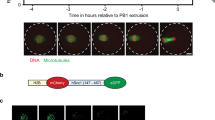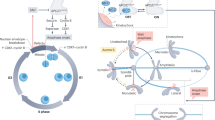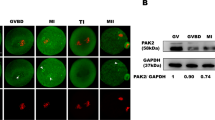Abstract
CONTROL of the metaphase to anaphase transition is a central component of cell-cycle regulation. Arrest at either metaphase I or II before fertilization is a common component of oogenesis in many organisms1. In Drosophila melanogaster females, this arrest occurs at meiosis I with the chiasmate bivalents tightly massed at the metaphase plate and the nonexchange chromosomes positioned between the plate and the poles on long tapered spindles2. Meiosis resumes only after passage through the oviduct3,4. Thus, metaphase arrest defines an important checkpoint in the meiotic cell cycle1. We report here that this arrest results from the balancing of chiasmate bivalents at the metaphase plate. Two meiotic mutations, mei-9b and mei-218a4, both of which greatly reduce the frequency of chiasma formation, bypass the metaphase block and allow stage 14 oocytes to finish both meiotic divisions without arrest. We conclude that metaphase arrest results from the balancing of kinetochore forces due to chiasmata.
This is a preview of subscription content, access via your institution
Access options
Subscribe to this journal
Receive 51 print issues and online access
$199.00 per year
only $3.90 per issue
Buy this article
- Purchase on Springer Link
- Instant access to full article PDF
Prices may be subject to local taxes which are calculated during checkout
Similar content being viewed by others
References
Murray, A. W. Nature 359, 599–604 (1992).
Theurkauf, W. E. & Hawley, R. S. J. Cell Biol. 116, 1167–1180 (1992).
Sonnenblick, B. P. in Biology of Drosophila (ed. Demerec, M.) 62–167 (Hafner, New York, 1965).
King, R. C. Ovarian Development in Drosophila melanogaster (Academic, New York, 1970).
Carpenter, A. T. C. & Baker, B. S. Genetics 71, 255–286 (1972).
Carpenter, A. T. C. & Sandier, L. Genetics 76, 453–475 (1974).
Baker, B. S. & Hall, J. C. in The Genetics and Biology of Drosophila Vol. 1a (eds Ashburner, M. & Novitski, E.) 351–434 (Academic, New York, 1976).
Zhang, P. & Hawley, R. S. Genetics 125, 115–127 (1990).
Carpenter, A. T. C. Cold Spring Harb. Symp. quant. Biol. 49, 23–29 (1984).
Carpenter, A. T. C. Chromosoma 75, 259–292 (1979).
Lindsley, D. L. & Zimm, G. G. The Genome of Drosophila melanogaster (Academic, San Diego, 1992).
Nicklas, R. B. Genetics 78, 205–213 (1974).
Hawley, R. S. in Genetic Recombination (eds Kucherlapati, R. & Smith, G. R.) 497–527 (American Society for Microbiology, Washington DC, 1988)
Puro, J. & Nokkala, S. Chromosoma 63, 273–286 (1977).
Author information
Authors and Affiliations
Rights and permissions
About this article
Cite this article
McKim, K., Ko Jang, J., Theurkauf, W. et al. Mechanical basis of meiotic metaphase arrest. Nature 362, 364–366 (1993). https://doi.org/10.1038/362364a0
Received:
Accepted:
Published:
Issue Date:
DOI: https://doi.org/10.1038/362364a0
This article is cited by
-
The chromosomal basis of meiotic acentrosomal spindle assembly and function in oocytes
Chromosoma (2017)
-
A single mutation results in diploid gamete formation and parthenogenesis in a Drosophila yemanuclein-alpha meiosis I defective mutant
BMC Genetics (2010)
-
Spindle assembly in the oocytes of mouse and Drosophila – similar solutions to a problem
Chromosome Research (2007)
-
The synaptonemal complex and meiotic recombination in humans: new approaches to old questions
Chromosoma (2006)
Comments
By submitting a comment you agree to abide by our Terms and Community Guidelines. If you find something abusive or that does not comply with our terms or guidelines please flag it as inappropriate.



